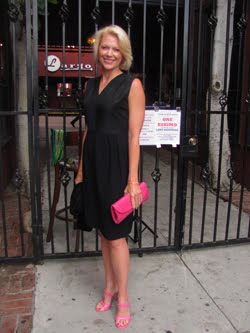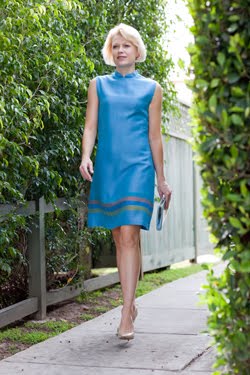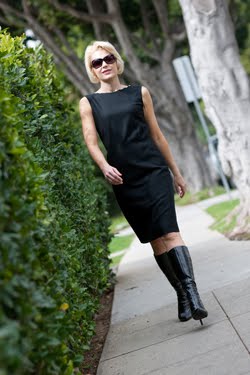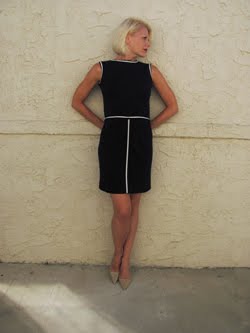Though many articles have been written about director Clarence Badger's 1927 classic It, most only seem to be scratching the surface. So much that we take for granted today can be traced back to the legendary silent film, and a considerable amount of insight comes from understanding the stories behind its iconic style.
Rudyard Kipling is actually the author who first mentioned the mysterious magnetism of "It" in a 1904 short story, but most today credit Elinor Glyn with the concept. Elinor is fascinating for her connections to both fashion and film. Her sister was Lucy, Lady Duff-Gordon, head of the European fashion house Lucile. The couturier was popular with the world's social elite--think royalty, aristocracy, and celebrity--and training ground for many a great costume designer, including Robert Kalloch and Travis Banton. In Hollywood, Elinor's powerful friends included Charlie Chaplin, Marion Davies, and Marion's longtime lover William Randolph Hearst. Hearst hired Elinor to write a two-part piece for his Cosmopolitan magazine, a story that was so popular it quickly became the basis for this film. In fact, both she and the fashion magazine appear in It, one of the earliest examples of product placement. Consulted on who should be cast as the leading lady, Elinor agreed with producers that only one woman in Hollywood possessed that certain sex appeal while simply being herself--Clara Bow. Thus, Clara became the original "It Girl," a term we still use (and overuse) today on an array of actresses, models, or socialites who are considered popular and of the moment.
Clara was actually far from fashionable at first. She had a bleak upbringing in Brooklyn, New York--poor beyond belief with a mother affected by seizures and psychosis due to a fall. Her mother even tried to kill her; Clara awoke late one night to find a knife pressed sharply against her throat, and was so traumatized that she would battle insomnia for the rest of her life. That was the kind of life Clara endured from the moment she was born...literally fighting to survive. As a result, she became street smart and strong, known even among the guys in the neighborhood for having a serious right hook. The positive side is that this experience gave her a maturity beyond her years and confidence that translated onscreen when she auditioned as a teenager. No matter who she acted against or whatever material she did, it was always Clara who lit up the screen. Her effervescence left a lasting impression with audiences and Hollywood producers began to see her as the next great star.
Ironically, someone who was NOT a fan of Clara was It's costume designer Travis Banton. He would come on strong in the 1930s and set much of that decade's style, including iconic work for friend Marlene Dietrich in movies like Morocco (1930) and Shanghai Express (1932). He favored a long and lean silhouette, and would be renowned for sensual bias cut gowns on lovelies like Carole Lombard and Kay Francis. In contrast, his early days at Paramount working on It were much more frustrating. Physically, Clara's 5'3" stature was in stark contrast to those other stars he loved...she was shorter and stouter, and started battling weight gain at every turn. Her tough upbringing and lack of ladylike ways also did not impress Banton, who preferred women to move like models and draw long lines with every step. Clara, in contrast, openly clashed with Banton's style sensibilities (she also battled Edith Head on Wings that same year) and seemed to bounce around like a boy. Remarkably, none of that tension is apparent onscreen and all of the artists came together to make a movie for the ages.
Banton did, unfortunately, underestimate Clara's own innate sense of
style, which made both an immediate and lasting impact in fashion. Their divide was largely due to the decades--Clara was a child of the 1920s and Banton was a visionary already looking toward the 1930s. As with any style star, it is how Clara carried herself that makes the 1920s still seem so fresh and It offers a wealth of inspiration. Her short accordion pleated
skirts could not be hotter with examples all over the fashion runways for the past few years.
Her trademark scarves--Clara's own offscreen style as well--are now part of any fashionista's accessory arsenal, particularly popular with ladies here in LA. Then there's Clara's wild asymmetrical bob. Though Colleen Moore was one of the first to bob her hair in Flaming Youth (1923) and Louise Brooks was the one to make it iconic in movies like Pandora's Box (1929), Clara Bow blew everyone away with the untamed nature of her voluminous short hair. It was also fiery red, her natural color enhanced even more by henna treatments. Those qualities found in her hair seem a perfect metaphor for Clara herself, who had a wild reputation both on and off the screen. For many both then and now--such as Mark Bridges (The Artist) and Catherine Martin (The Great Gatsby), costume designers for movies that acted as bookends to the recent Art Deco trend in fashion--Clara Bow remains THE
image of the quintessential flapper.
Though Clara's style is still so admired, Banton's costume design contributions in It have been particularly significant. One contribution can be summed up in four words--the Little Black Dress. As many know, Coco Chanel's October 1926 collection included her now iconic "Ford" dress (so named because, like the Model T Ford, it only came in black). Today we speak with great reverence of this being the first LBD, but it's important to realize that it did not immediately catch on at the time. In fact, Vogue only included a small sketch of the simple longsleeve black dress, and it was largely overshadowed by other couture of the day a la Patou, Paquin, and Lanvin. But Banton clearly sensed a shift in the style universe and within mere months chose to make a Little Black Dress the opening ensemble for It. Further, it was a dress that went from day to night, transformed courtesy of a makeover that would inspire many other films such as 1986's Pretty in Pink.
All of this was relatively unheard of at the time. Though some couturiers had been playing with black in their collections from time to time--Lucile, where Banton had worked, was known for being one of the first--and black was occasionally worn by their wealthy clientele, it did not have mass appeal. The average woman had not yet embraced it. This is who Chanel appealed to with her practical and diplomatic fashion, and this who went to the movies and was inspired by its stars. Quite simply, before October 1926, the average woman would usually only wear black to funerals. Within a few short months, when It had its premiere in February 1927, all women considered working black into their everyday wardrobes. This was a serious shift in mainstream fashion. It helped set us on the path for black to become the beauty basic it is today. The final push would come in the 1950s and 1960s courtesy of two other movies and Hubert de Givenchy--Sabrina (1954) and Breakfast at Tiffany's (1961). Though Chanel certainly deserves credit for drawing a historic line in the sand with her "Ford" dress, it seems that the Little Black Dress would not have been accepted so widely and with such speed if Banton had not included it in his costumes for Clara. That is the power of film.
1927's It is a delight to watch, mostly because of the natural charm of Clara Bow. But it continues to be culturally relevant largely because of costume design that was influential both then and now. The silent film is a cornerstone of 1920s design for any looking to do period pieces today, such as The Artist and The Great Gatsby. And for those in fashion, it is a landmark...significant to a degree that even the industry doesn't fully appreciate for its role in popularizing the Little Black Dress. You can still find many vintage examples from the 1920s that look like virtual knock-offs of Clara's LBD from this movie as well as modern interpretations inspired by it in fashion today. There are also many other fashions from the movie that are on trend, which you will see below. Though beloved by silent cinema fans, It remains popular with an even wider audience because of its inspirational iconic style.
All of this was relatively unheard of at the time. Though some couturiers had been playing with black in their collections from time to time--Lucile, where Banton had worked, was known for being one of the first--and black was occasionally worn by their wealthy clientele, it did not have mass appeal. The average woman had not yet embraced it. This is who Chanel appealed to with her practical and diplomatic fashion, and this who went to the movies and was inspired by its stars. Quite simply, before October 1926, the average woman would usually only wear black to funerals. Within a few short months, when It had its premiere in February 1927, all women considered working black into their everyday wardrobes. This was a serious shift in mainstream fashion. It helped set us on the path for black to become the beauty basic it is today. The final push would come in the 1950s and 1960s courtesy of two other movies and Hubert de Givenchy--Sabrina (1954) and Breakfast at Tiffany's (1961). Though Chanel certainly deserves credit for drawing a historic line in the sand with her "Ford" dress, it seems that the Little Black Dress would not have been accepted so widely and with such speed if Banton had not included it in his costumes for Clara. That is the power of film.
1927's It is a delight to watch, mostly because of the natural charm of Clara Bow. But it continues to be culturally relevant largely because of costume design that was influential both then and now. The silent film is a cornerstone of 1920s design for any looking to do period pieces today, such as The Artist and The Great Gatsby. And for those in fashion, it is a landmark...significant to a degree that even the industry doesn't fully appreciate for its role in popularizing the Little Black Dress. You can still find many vintage examples from the 1920s that look like virtual knock-offs of Clara's LBD from this movie as well as modern interpretations inspired by it in fashion today. There are also many other fashions from the movie that are on trend, which you will see below. Though beloved by silent cinema fans, It remains popular with an even wider audience because of its inspirational iconic style.
Writer-producer of It, Elinor Glyn gives her definition of what "It" is
as she did in an article in Cosmopolitan magazine
as she did in an article in Cosmopolitan magazine
Glyn believed Clara Bow to be the only woman in Hollywood at the time who truly had "It"
Vivacious shopgirl Betty Lou Spence (Bow)
has her sights set on department store owner Cyrus Waltham, Jr. (Antonio Moreno, below right)
We see Travis Banton's Little Black Dress for Betty Lou as
Waltham's friend Monty (William Austin) invites her out to a fancy restaurant
Perhaps the earliest makeover scene in which a character transforms a dress from day to evening...
Pretty in Pink would famously do this again in 1986
Pretty in Pink would famously do this again in 1986
A great shot of the Little Black Dress now transformed for Betty Lou's evening out
where she bumps into her boss at an expensive restaurant
Clara's hair was also inspirational, and here you can see the short angled cut
that would inspire many women of the Jazz Age
On trend today, Banton put Betty Lou in a patterned sweater and short accordion pleated skirt
for her first date with Cyrus at an amusement park
Possibly yet another Little Black Dress on Betty Lou at work
(though I've seen it colorized in green)
You can see that Clara's hemline is a little higher than the others,
which Banton did to help elongate her shorter stature
From the hat to the coat to the clothes underneath,
this is a look of flapper girls which was so popular the whole outfit appeared in magazines
Scarves were a huge part of the look of Clara Bow both on and offscreen
and worked wonderfully well with her hair
Josef von Sternberg acted as an Assistant Director on this film (uncredited)
and there are certain moments where I can feel his touch
Director Clarence Badger cleverly frames the title of the movie from the name on the boat
and ends it all with a triumphant kiss between two stars with "It"














































































































12 comments:
Brace yourself, Kimberly, I've never even watched this film! Shocker! But I love the fact that the LBD was suddenly THE thing to wear. That's the power of film in the world of fashion, isn't IT?
Loved this! Hugs, Kay
Kimberly, I had no idea Travis Banton had a role in the ascension of the LBD - nor did I know that Josef von Sternberg was involved in "It" (a film I haven't seen but have just put on order). I learn so much at GlamAmor - thank you!
Ok, Kay, I was STUNNED that you had never seen IT. But that's what I love about classic cinema--no matter how much you think you've seen, no matter how much you think you know, there is ALWAYS more to discover and to love. Though I wasn't blown away by the plot or anything like that when I first saw it, what I have come to appreciate is the amount of influence that this movie has had (obviously). With that, I now am able to look at the movie and enjoy much more about it. Because we now have a century of film behind us, it's hard to maintain a perspective that this was a film of firsts, not the least of which is an entire genre of films such as romantic comedies and again the whole makeover storyline. Really remarkable. I look forward to hearing your thoughts after you see it!
And you, too, Patricia, have never seen IT? As I mentioned to Kay, it's not like the plot will blow you away or anything--it's no CITIZEN KANE. lol That said, there's a lot of firsts there and just how incredible that both Clara Bow and Travis Banton have had such a long-lasting impact on fashion and what we all think of when we hear "1920s style." It's truly something that people in both fashion in film turn to again and again for inspiration. I look forward to hearing your thoughts on it all, too!
I'm another one who hasn't seen "IT", but I have it on my DVR, waiting for an evening when I can savour it without interruption.
I loved this post, and the history of the LBD. I can't believe I haven't seen this film already!
I can't believe you haven't seen it either, Silver Screenings! This has just been a revelation as I would have assumed that all three of you would have seen it at least once. Fascinating. Well, I look forward to hearing your impressions of it, too! :)
I saw "It" a few months ago on TCM's "Silent Sunday Night"; it's a very charming film, and Bow's magnetism carries it through. What's unfortunate is that all four of her features from 1928, when she still was riding high, are presumed lost. Aside from a few surviving stills from each of these movies, we really have no idea of her fashion impact in those films.
Gosh, so tragic! We know that the country was nuts for Clara Bow and the influence of her style was running high--IT shows us some of the reason why--so it's a loss to us that those 4 movies are gone. Hopefully, like some others, a copy of at least one will be found somewhere. Sometimes historians will unearth a copy in another country--I think one of Gloria Swanson's lost movies was found that way. Fingers crossed. Thanks for the comments!
I have seen "It" more than once and love the many scenes in its film world of department stores and play-boats for the rich. I just finished reading "Clara Bow" Running Wild" by David Stenn and was stunned to realize that I've always underestimated Bow's stardom. Even when her ability to perform in films was tottering at the end of the 1920s, she was the top or one of the very top box office draws.
Thanks for your comments, Brenda! Yes, Clara was a HUGE star and that's one of the reasons that what she wore--both on and offscreen--made such an impact with women. She's also got one heck of an interesting story with regards to her life. Really incredible. Happy to hear you've been learning more about it!
Loved the article! I didn't know about Banton's contributions to "It" either. But I have to point out that Bow was not the one to popularize short hair. Hollywood started showing bobbed-haired flappers as far back as 1920 with Olive Thomas (https://www.youtube.com/watch?v=K4N7kxtjaf4), and Colleen Moore made the biggest splash with her bob ("Flaming Youth," 1923). Leatrice Joy was famous for having the most daringly short cut. It was rare, by 1927, for a silent-film star to have long hair. You can read a fun article about "The Battle of Bobbed Hair" in the April 1924 issue of "Photoplay," available on archive.org. Bow's hair stands out to me because of its almost futuristic bouffant style; I don't think I've seen that on anyone besides her.
I'm having trouble with the idea that "before October 1926, women really only wore black to funerals." Lanvin did black evening dresses in the early 1920's, and I've seen many a satiny black-clad temptress in films pre-Bow (e.g., Bebe Daniels in "Why Change Your Wife?"). It's hard to be sure that the dresses are really black, but they look it as much as Clara's "It" dress does. This is something I'd like to know more about.
But I think you're really onto something with the idea that Bow made a big impact on fashion--she was certainly hugely popular, and probably had more influence on popular culture than most of us realize.
Thank you HarriedCustomer for your thoughtful comments! You're quite right about the short hair--several ladies popularized the bob before Clara. What was famous about her hair--and people were mad about it--was how wild it was. That was very different than the others. It had a lot of volume and always seemed to be a bit out of control, which seems an appropriate metaphor for Clara. It was also red, which people loved, though they didn't know that until she was seen in magazines.
You also make a good point about the color black. This is something I've continued to discuss with other experts. You're quite right that other designers used black in their collections--Travis Banton himself worked at the Lucile couturier and she was known for being one of the first to use black. And you bring up Lanvin and the clothes in WHY CHANGE YOUR WIFE?, many of which were couture. I think that's the point I'm not making well and that the fashion industry itself is not making well with its long-asserted claim of Chanel and her "Ford" dress--though people in couture were using black and those buying couture may have been wearing it (though still not nearly as frequently as we see it today), the general masses were not. That is the group that Chanel appealed to with her practical and diplomatic fashion, and that is the group that went to the movies and were inspired by its stars. The shift I discuss is about mainstream fashion. You can still find many vintage examples from the 1920s that look like virtual knock-offs of Clara's LBD in this movie. It became very popular.
Thanks again for your comments. I've been meaning to circle back to this article and make a few tweaks and you've inspired me to do so. :)
Post a Comment